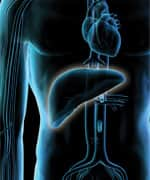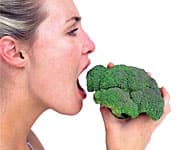Life Extension Magazine®
One important way to protect yourself from the lethal scourge of cancer that is destroying the lives of millions of Americans is to regularly consume cruciferous vegetables such as broccoli, cauliflower, cabbage, and Brussels sprouts. This particular group of vegetables is an excellent source of unique cancer-fighting chemicals known as glucosinolates. Once inside the body, glucosinolates are transformed into powerful metabolites such as indole-3-carbinol (I3C) and isothiocyanates (including sulforaphane). These phyto-chemical compounds have been shown to protect against a broad range of potentially lethal threats, including colon, breast, prostate, thyroid, cervical, and other cancers.1-22 Attacking CancerThe remarkable compounds derived from broccoli work through numerous mechanisms to inhibit cancer cells. Some produce beneficial changes in gene expression, thus altering levels of key proteins and enzymes, while others inhibit tumor cell adhesion, spread, and invasion. Most recently, scientists have shown that a particular cruciferous vegetable compound known as phenethyl isothiocyanate (PEITC) directly inhibits a tumor’s ability to supply itself with blood.2 This interruption of angiogenesis is considered an important cancer-fighting mechanism. Another broccoli compound known as sulforaphane induces cancer cells to commit cellular suicide, while other compounds—particularly I3C, or its condensation product, 3,3’-diindolyl-methane (DIM)—interrupt the ability of cancer cells to reproduce.1,3,4,7,9,10 “I3C and DIM affected the expression of a large number of genes that are related to the control of carcinogenesis, cell survival, and physiologic behaviors,” noted one research team.22 Recent studies suggest that at high concentrations, these compounds may interact with one another to thwart cancer in a synergistic manner. In order to achieve a high enough concentration of these effective cancer-fighting compounds, it may be necessary to also use supplements.3
Scientists in California demonstrated that I3C interferes with breast cancer cell proliferation by altering the size of a protein associated with cellular reproduction. As a result, cellular division grinds to a halt, as if a monkey wrench had been thrown into the gears of the cell’s machinery.4 Runaway cell division is a hallmark of cancer; I3C appears to restore balance by commandeering the body’s own protein-producing capability and using it to halt rampant cell division. Supporting DetoxificationBroccoli compounds also modulate the activity of enzymes in the liver, which enhances natural detoxification pathways. The protective effect of these phytochemicals may arise from their ability to inhibit the carcinogen-activating phase I liver enzymes, while inducing the carcinogen-detoxifying phase II enzymes. The critically important phase II enzymes convert dangerous compounds, such as toxins, hormones, and xenoestrogens (estrogen-like compounds from the environment), into less toxic compounds that can safely be eliminated by the body.5-7,23,24
Rich in NutrientsIn addition to its unique cancer-fighting phytochemicals, broccoli is an excellent source of vitamins C, K, and A, as well as folate and dietary fiber. It is considered a very good source of minerals, such as manganese, potassium, magnesium, and phosphorus, and vitamins such as riboflavin (vitamin B2) and pyridoxine (vitamin B6). ConclusionBroccoli makes a healthful addition to the daily diet. In addition to providing valuable vitamins, minerals, and fiber, broccoli offers an abundance of powerful phytochemicals that may help protect the body against deadly cancers.
| |||||
| References | |||||
| 1. Pledgie-Tracy A, Sobolewski MD, Davidson NE. Sulforaphane induces cell type-specific apoptosis in human breast cancer cell lines. Mol Cancer Ther. 2007 Mar;6(3):1013-21. 2. Xiao D, Singh SV. Phenethyl isothiocyanate inhibits angiogenesis in vitro and ex vivo. Cancer Res. 2007 Mar 1;67(5):2239-46. 3. Pappa G, Strathmann J, Lowinger M, Bartsch H, Gerhauser C. Quantitative combination effects between sulforaphane and 3,3’-diindolylmethane on proliferation of human colon cancer cells in vitro. Carcinogenesis. 2007 Feb 28. 4. Garcia HH, Brar GA, Nguyen DH, Bjeldanes LF, Firestone GL. Indole-3-carbinol (I3C) inhibits cyclin-dependent kinase-2 function in human breast cancer cells by regulating the size distribution, associated cyclin E forms, and subcellular localization of the CDK2 protein complex. J Biol Chem. 2005 Mar 11;280(10):8756-64. 5. Rogan EG. The natural chemopreventive compound indole-3-carbinol: state of the science. In Vivo. 2006 Mar;20(2):221-8. 6. Kristal AR, Lampe JW. Brassica vegetables and prostate cancer risk: a review of the epidemiological evidence. Nutr Cancer. 2002;42(1):1-9. 7. Fowke JH, Morrow JD, Motley S, Bostick RM, Ness RM. Brassica vegetable consumption reduces urinary F2-isoprostane levels independent of micronutrient intake. Carcinogenesis. 2006 Oct;27(10):2096-102. 8. Aggarwal BB, Ichikawa H. Molecular targets and anticancer potential of indole-3-carbinol and its derivatives. Cell Cycle. 2005 Sep;4(9):1201-15. 9. Sarkar FH, Li Y. Indole-3-carbinol and prostate cancer. J Nutr. 2004 Dec;134(12 Suppl):3493S-8S. 10. Plate AY, Gallaher DD. Effects of indole-3-carbinol and phenethyl isothiocyanate on colon carcinogenesis induced by azoxymethane in rats. Carcinogenesis. 2006 Feb;27(2):287-92. 11. Bonnesen C, Eggleston IM, Hayes JD. Dietary indoles and isothiocyanates that are generated from cruciferous vegetables can both stimulate apoptosis and confer protection against DNA damage in human colon cell lines. Cancer Res. 2001 Aug 15;61(16):6120-30. 12. Tadi K, Chang Y, Ashok BT, et al. 3,3’-Diindolylmethane, a cruciferous vegetable derived synthetic anti-proliferative compound in thyroid disease. Biochem.Biophys.Res Commun. 2005 Nov 25;337(3):1019-25. 13. Kim YS, Milner JA. Targets for indole-3-carbinol in cancer prevention. J Nutr Biochem. 2005 Feb;16(2):65-73. 14. Brew CT, Aronchik I, Hsu JC, et al. Indole-3-carbinol activates the ATM signaling pathway independent of DNA damage to stabilize p53 and induce G1 arrest of human mammary epithelial cells. Int J Cancer. 2006 Feb 15;118(4):857-68. 15. Chang X, Tou JC, Hong C, et al. 3,3’-Diindolylmethane inhibits angiogenesis and the growth of transplantable human breast carcinoma in athymic mice. Carcinogenesis. 2005 Apr;26(4):771-8. 16. Manson MM, Farmer PB, Gescher A, Steward WP. Innovative agents in cancer prevention. Recent Results Cancer Res. 2005;166:257-75. 17. Shukla Y, Kalra N, Katiyar S, Siddiqui IA, Arora A. Chemopreventive effect of indole-3-carbinol on induction of preneoplastic altered hepatic foci. Nutr Cancer. 2004;50(2):214-20. 18. Garikapaty VP, Ashok BT, Chen YG, et al. Anti-carcinogenic and anti-metastatic properties of indole-3-carbinol in prostate cancer. Oncol Rep. 2005 Jan;13(1):89-93. 19. Rahman KW, Sarkar FH. Inhibition of nuclear translocation of nuclear factor-{kappa}B contributes to 3,3’-diindolylmethane-induced apoptosis in breast cancer cells. Cancer Res. 2005 Jan 1;65(1):364-71. 20. Qi M, Anderson AE, Chen DZ, Sun S, Auborn KJ. Indole-3-carbinol prevents PTEN loss in cervical cancer in vivo. Mol Med. 2005 Jan;11(1-12):59-63. 21. Myzak MC, Tong P, Dashwood WM, Dashwood RH, Ho E. Sulforaphane retards the growth of human PC-3 xenografts and inhibits HDAC activity in human subjects. Exp Biol Med (Maywood.). 2007 Feb;232(2):227-34. 22. Li Y, Chinni SR, Sarkar FH. Selective growth regulatory and pro-apoptotic effects of DIM is mediated by AKT and NF-kappaB pathways in prostate cancer cells. Front Biosci. 2005 Jan 1;10:236-43. 23. Zhou C, Poulton EJ, Grun F, et al. The dietary isothiocyanate sulforaphane is an antagonist of the human steroid and xenobiotic nuclear receptor. Mol Pharmacol. 2007 Jan;71(1):220-9. 24. Myzak MC, Dashwood RH. Chemoprotection by sulforaphane: keep one eye beyond Keap1. Cancer Lett. 2006 Feb 28;233(2):208-18. 25. Available at: http://www.nutritiondata.com/facts-B00001-01c20c0.html. Accessed March 27, 2007. 26. Available at: http://whfoods.org/genpage.php?tname=foodspice&dbid=9#nutritionalprofile. Accessed March 23, 2007. |



